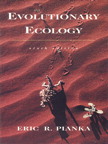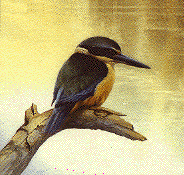
Suggested Additional Reading: Exams: Three in-class exams during the semester (only the best two will be counted) plus one comprehensive final, scheduled as follows: 
Download sample first exam Download sample second exam Download sample third exam How to get straight A's Letter Grade: Your lowest hour exam will be thrown out (no "make up" exams!) Your best two exams will each count 25% of your course letter grade. The comprehensive Final will count as 50% of your course grade. 
Course Outline, Biology 357: Evolutionary Ecology Background Scaling and the hierarchical structure of biology, levels of approach in biology, domain of ecology, definitions and ground work; anthropocentrism, the importance of wild organisms in pristine natural environments, the urgency of basic ecological research; scientific methodology; models; multiple causality; limiting factors, tolerance limits, the principle of allocation; natural selection, self-replicating molecular assemblages; units of selection. Principles of Population Ecology Life tables and schedules of reproduction; net reproductive rate and reproductive value; stable age distribution; Leslie matrices; intrinsic rate of increase; evolution of reproductive tactics; avian clutch size; evolution of old age and death rates; population growth and regulation -- Pearl-Verhulst logistic equation; density dependence and independence; r and K selection; population "cycles," cause and effect; use of space (vagility, home range, territoriality, foraging tactics); evolution of sex; sex ratio; mating systems; sexual selection; fitness and the individual's status in the population; kin selection, reciprocal altruism, parent-offspring conflict. Interactions Between Populations Parasitism, Commensalism, Mutualisms, etc.; Direct versus indirect and complex population interactions. Competition and Niche Theory: Lotka-Volterra equations and competition theory; diffuse competition; niche overlap and competition; niche dimensionality; niche breadth (specialization versus generalization); evolutionary consequences; laboratory and field experiments; other evidence from nature; future prospects. Predation: Theory; predator-prey oscillations; aspect diversity; "prudent" predation and optimal yield; evolutionary consequences; predator escape tactics; adaptive coloration; mimicry; warning calls; coevolution; plant-herbivore interactions and plant-apparency theory; selected other observations and experiments. The Role of Phylogenetics in Ecology Phylogenetic systematics, independent contrasts, the comparative method, evolutionary ecomorphology Community Ecology Macrodescriptors; compartmentation in communities (trophic levels, guild structure, and food webs); connectance; pyramids of numbers, biomass, and energy; energy flow and ecological energetics; secondary succession and transition matrices; community matrix; saturation with individuals and with species; species diversity; diversity of lowland rainforest trees; community stability; chaotic attractors; evolutionary convergence and ecological equivalents; evolution of communities; pseudo-communities. Island Biogeography and Conservation Biology Classical biogeography; biogeographic "rules;" continental drift; island biogeography; species-area relationships; equilibrium theory; compression hypothesis; islands as ecological experiments: Krakatau, Darwin's finches, Hawaiian Drosophilidae, other examples; metapopulations, conservation biology, human impacts on natural ecosystems, hot spots of biodiversity, applied biogeography and the design of nature preserves. |